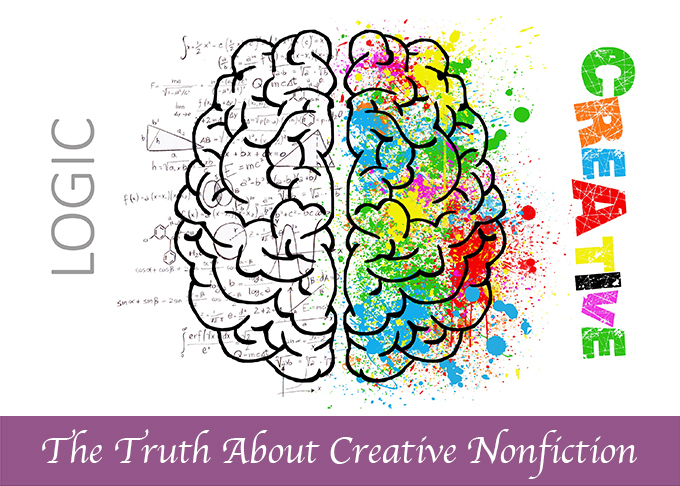The Truth About Creative Nonfiction
I wanted to discuss a little today about what the term “creative nonfiction” means. Everything you read has some bias to it, some judgement, some slant: even news articles can’t include every fact, and the ones they choose to tell share some of their personality and beliefs with us.
Autobiographies and biographies work this way, too. Stories about a person’s life are often mostly true, not always altogether the fact-by-fact representation—especially for
Lives don’t unfold like stories, and in order to read—and get inspired by—a person’s tale, it needs to live and breathe like a story, not just a random assortment of facts and figures.
If you read my published “Toxic Tastings” story for
Upon thinking over it more, though, I would publish this story as-is even in a memoir category. The truth of the event is in there; the real details would simply muddy the waters and be confusing to the reader.
I’ll share my first draft here so you can see what I mean:
Toxic Tastings: First Draft
Have you ever been poisoned—by a parent, no less? I have.
This one day in a quintessential Jersey diner, of which there are approximately 50,000 in the state, I was eating lunch with my mom and stepdad. I ate a BLT and disco fries, which, if you don’t know, are a scrumptious concoction of french fries smothered in brown gravy and mozzarella cheese. It served as the perfect almost-last meal.
The catalyst to my poisoning arrived shortly after.
“Excuse me,” an elderly gentleman said, addressing my stepfather. He was dressed in a suit and wore a name tag with “Manager” written on it. He pointed at my stepfather’s ball cap. “Is that true? Are you an army vet?”
“Sure am,” my stepfather replied. “Proud member of the VFW since Vietnam.”
“Well, thank you very much for your service,” the man said, reaching out to shake my stepfather’s hand. In the other, he produced a small pudding in a glass sundae dish. “Here, let me treat you to dessert in honor of your sacrifice.”
My stepfather gratefully accepted, and the man left. He took a bite of the layered chocolate-and-brown concoction. “Wow, this is delicious. Here, hon, you have to try some.”
He fed a spoonful to my mom, who reacted with equal exuberance.
They were basking in their mutual
mouth-gasms when “the moment” descended upon our tiny table. My mom turned to me with a spoonful to taste.“What is it?” I asked with skepticism.
“Just try it. You’ll love it,” Mom said.
Famous last words.
My taste buds imploded as a monstrosity of flavors descended on their fragile, unwitting existences. My face contorted with the pain of a thousand METAPHOR HERE as the
most vile tastes on the planet invaded my mouth. I choked and gagged my way through swallowing the lump of SOMETHING.My eyes tear as I grab the glass of water in front of me and wash out my scorched throat.
“What…Is…THAT.”
My mom stares at me with a confused expression. “Tiramisu.”
Oh, you mean just the amalgamation of the two most vile tastes on the planet, coffee
and alcohol? Thanks, Mom! Areyou trying to poison me?!I lived to tell the tale, obviously—but I no longer trusted when Mom puts things in front of me without identification. She’s pulled that trick for the last time. Pickled beets, corn beef hash, anything to do with onions…and now TIRAMISU. My poor supertaster tastebuds just don’t know what to do with her anymore.
See the difference? The details are muddled. We don’t know who this manager guy is who gives my stepfather the dessert, and we don’t see him again. Since the story begins with talk of a poisoning, he could have served a dish full of poison. Who knows?
Not the reader, because they don’t know what kind of story this is yet.
I don’t discuss what a supertaster is, because that wasn’t part of the original conversation. Confusing, right? You the reader have no idea what that is because you don’t carry my full load of experiences. Imagine that!
This is even a bigger point, too, because
I was actually visiting home after college, and I learned about supertasters through my job at Holtzbrinck Publishers, an academic publishing company. I attended the national sales meeting that year, where an author was presenting his book on biological psychology to the room full of sales representatives (and a few others, like me). He started out his presentation by directing us to all put a tasting strip in our mouths, which (unbeknownst to us) had a chemical on it that can determine how many tastebuds you have by how bitter the strip tastes. At my table of 10 or so, I was the only one who lunged across the table for the pitcher of water. He then explained why the few people in the room had this reaction, which led to my discovery of what a “supertaster” is.
Super-complicated—that’s what this explanation is. More importantly, it adds absolutely nothing to the story.
The important detail is that I had recently learned what a supertaster was, I was one, and that I had explained that to Mom. End of actual story.
At the end of my final version, even Mom giving me the tea in response is made-up, but it adds to the story because it escalates the situation. Here, we have me practically dying (only a slight exaggeration!) from Mom feeding me tiramisu, and then she tries to fix it by handing me something of equal or worse taste: tea.
It’s funny. It works. And better still, my mom read the story and didn’t even remember that was false, claiming it was perfectly plausible for that to have happened.
So, there you have it. A breakdown on what creative nonfiction actually looks like. Some people get upset when they find out that their favorite stories are not 10% true to life, but what they don’t understand is that those stories wouldn’t be their favorites if they were written that way.
That being said, there ARE poor examples of stories claiming to be creative nonfiction who take the “creative” part far too liberally, in my opinion.
Saving Mr. Banks is the first and most egregious that comes to mind (though I love the movie), but it’s far from the only example. Just know that whenever you’re reading/watching/ingesting “true” stories, there is always some made up detail to make the story more palatable, more “Hollywood,” etc.
Enjoy the book/movie/whatever, and then go do your own research on the subject to get the true story and see just how much was changed for the sake of art.
Happy reading, happy watching, and please: the next time you’re reading “nonfiction,” remember that the truth of the whole is greater than the truth of its parts.
Are there any stories you tell where you leave out details for the sake of the greater Truth (or punchline)? Share in the comments below?


